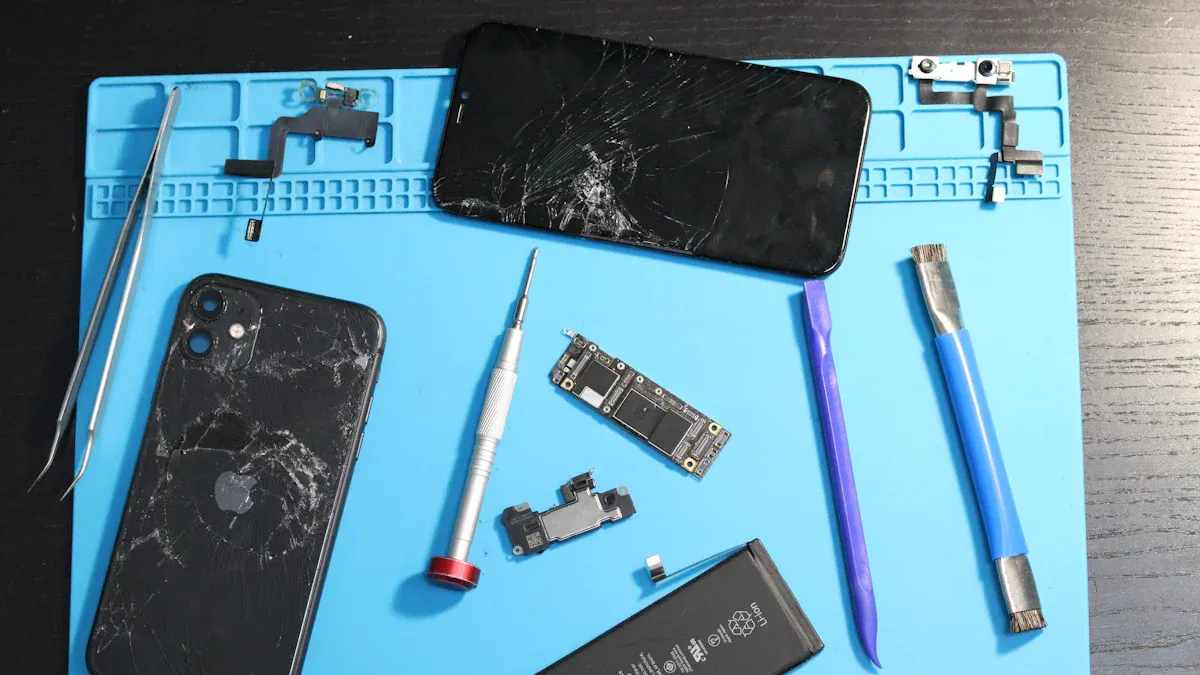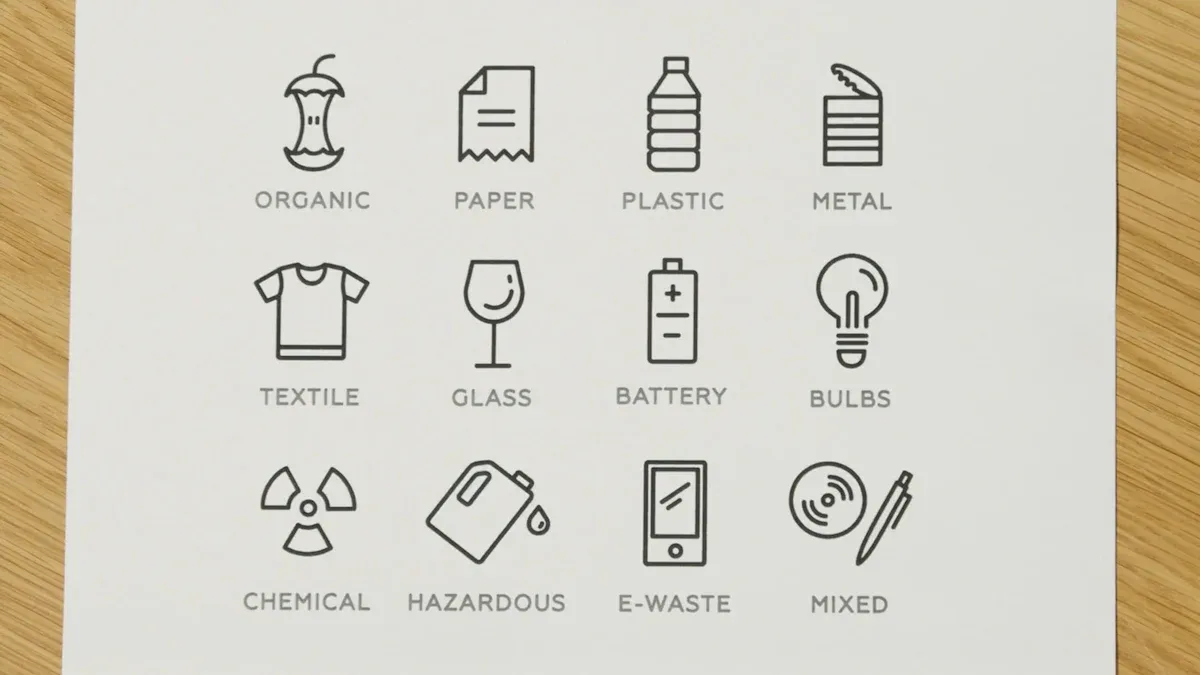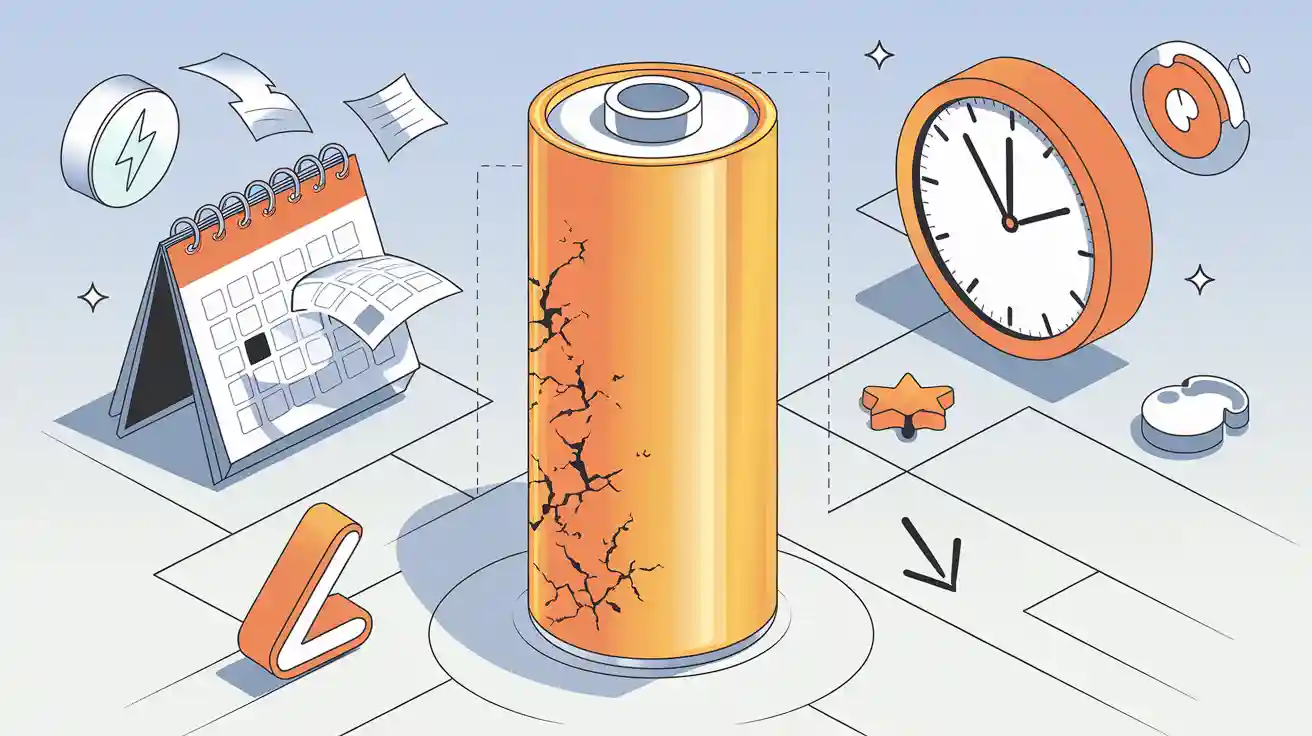Why Does The Cycle Life of Lithium Battery Become Short?
You might see your lithium battery working less well as time goes by. Many things can cause this, like deep discharges, chemical changes, stress from the environment, how you use it, and the quality of its parts. The table below lists common reasons why battery life gets shorter:
| Reason for Shortened Cycle Life | Description |
|---|---|
| Calendar Aging | Chemical reactions happen slowly all the time. This lowers the battery’s capacity. |
| Cycling-Based Degradation | Charging and discharging make the battery wear out faster. |
| Fast Charging | Charging quickly can hurt battery parts. |
| High Temperatures | Heat makes the battery age faster. |
| Overcharging/Overdischarging | Charging too much or too little can damage the battery. |
| Physical Abuse | Dropping or bumping the battery can break it. |
How much you drain the battery matters a lot. If you drain it deeply often, it will not last as long. Using only half of the battery’s power (50% DoD) can make it last up to twice as long as deep draining.
Key Takeaways
- Using up all the battery makes it die faster. Try to use only 20% to 80% of the battery charge. This helps the battery last longer.
- Charging the right way is very important. Charge the battery slowly. Do not charge it all the way to 100%. This keeps the battery working well.
- The battery’s quality is important. Pick batteries from brands you trust. Good materials help the battery work better and last longer.
- Keep the battery cool. Put it in a dry place. Stay away from hot places to stop damage.
- Check your battery’s health often. Regular checks help you find problems early. This keeps the battery working its best.
Key Factors Affecting Cycle Life
Depth of Discharge
Depth of discharge is important for battery life. If you use most of the battery before charging, it puts stress on the inside parts. This stress makes chemical reactions happen faster. The battery wears out quicker.
- Deep discharge makes the battery lose power faster and not last long.
- There is a bigger chance of over-discharging, which can hurt the battery forever.
- Draining the battery too much often makes the battery’s chemistry wear out more.
You can look at the table to see how different discharge levels change cycle life:
| Depth of Discharge (DoD) | Estimated Cycle Life |
|---|---|
| 100% DoD | 300–600 cycles |
| 50% DoD | ~1200–1500 cycles |
| 40% DoD | 1000–3000 cycles |
If you use your battery between 25% and 75% charge (50% DoD), it keeps about 74% of its power after 14,000 cycles. But if you always use all the charge (0% to 100%), it keeps only about 48% after the same number of cycles. Using full discharges often also makes more heat and resistance inside. This makes the battery get old faster.
Charging Habits
How you charge your battery changes how long it works. Good charging habits help your battery last longer. Bad habits make it wear out sooner.
- Charging very fast can make the battery too hot and shorten its life.
- Charging too much can hurt the battery and make it wear out faster.
- Keeping the battery charged above 80% makes it lose power faster.
- Charging slowly is better than charging quickly because it is easier on the battery cells.
- Charging to 80% instead of 100% helps the battery last longer.
If you charge your battery every day at 50%-55%, you use shallow discharges. This can make your battery last 10–13 years. If you charge every two days at 20%-25%, you use deep discharges, and your battery may only last 5–7 years. Using good charging methods helps your battery work better for longer.
Tip: Try not to charge your battery to 100% all the time. Aim for 80% if you can, and use slow charging when possible.
Material Quality
The materials inside your battery matter for how long it lasts. Good electrode and electrolyte materials help your battery stay healthy for more cycles. Bad materials or mistakes can cause problems early.
Problems during making, like metal pieces such as copper, can cause short circuits and make the battery wear out faster. These problems can make the battery fail early and be unsafe.
- Mistakes during making can make batteries stop working sooner.
- More copper in the battery’s active material makes it lose power.
- After 50 cycles, batteries with copper lose much more power than those with pure materials.
- At high discharge rates, batteries with copper can lose up to 85% of their power.
Picking batteries from trusted brands and checking for quality helps you avoid these problems. Good materials mean your battery will last longer and work better.
Chemical and Physical Degradation

Lithium batteries change inside as you use them. These changes make the battery store less energy over time. Let’s see why this happens.
Electrode Loss
The electrodes are very important parts of your battery. Over time, they lose some active material. This happens because of side reactions and stress. Using your battery at very high or low charge makes this worse. The positive electrode loses power faster when the battery is charged a lot. The negative electrode gets weaker at low charge. As your battery gets older, it holds less charge and its resistance goes up. You might also notice swelling or gas inside the battery.
Main problems are losing lithium and losing active material in the electrodes. These problems make your battery not last as long.
Electrolyte Breakdown
The electrolyte lets lithium ions move between electrodes. Over time, the electrolyte can break down. This happens faster at high heat or after many charges. When the electrolyte breaks down, it makes new chemicals. These can dissolve metals from the cathode. This happens more when the battery is hot. Your battery loses power faster because of this. At first, some chemicals in the electrolyte break down quickly. Later, other chemicals break down too, making the battery weaker.
- Electrolyte breakdown makes the battery lose power faster.
- High heat and lots of charging make this worse.
SEI Layer
The SEI layer forms on the negative electrode. It works like a shield. It lets lithium ions pass but stops more breakdown of the electrolyte. As you use your battery, the SEI layer gets thicker. A thick SEI layer makes it harder for the battery to give power. This also traps more lithium, so the battery can’t give as much energy. When the graphite in the electrode grows and shrinks, it can crack. This gives more space for the SEI layer to grow. This keeps happening and causes even more lithium loss.
The SEI layer helps protect your battery but also makes it age. Keeping this balance helps your battery last longer.
Environmental Impact
Temperature
Temperature plays a big role in how long your lithium battery lasts. You should keep your battery within its safe range, which is usually between −20 °C and 60 °C. If you use your battery outside this range, it can get damaged. High temperatures speed up chemical reactions inside the battery. This makes the battery lose power faster and shortens its life. When your battery gets too hot, it can even lead to dangerous problems like overheating or thermal runaway. If you store or use your battery at 45°C (113°F), it can wear out more than twice as fast as at 25°C (77°F). Try to keep your battery cool and away from direct sunlight.
Tip: Never leave your battery near a fire, heater, or in a hot car. Too much heat can make the battery swell, smoke, or even catch fire.
Humidity
Humidity can also harm your battery. When water gets inside, it reacts with the chemicals and causes damage. This can lead to corrosion and make the battery weaker over time. The table below shows some of the harmful reactions:
| Chemical Reaction | Consequence |
|---|---|
| H2O + LiPF6 → POF3 + LiF + 2HF | Makes hydrofluoric acid (HF), which is very corrosive. |
| ROCO2Li + HF → ROCO2H + LiF | Damages the SEI film, which protects the battery. |
| Li2CO3 + 2HF → H2CO3 + 2LiF | Uses up active lithium, so the battery stores less energy. |
If the SEI film gets damaged, your battery will have higher resistance and lose power faster. You will notice that your battery does not last as long after each charge.
Storage
How you store your battery affects its cycle life. You should follow these steps to keep your battery healthy:
- Store your battery at about 50-60% charged.
- Keep it in a cool place, between 10-25°C.
- Avoid very hot or cold spots, like above 30°C or below -20°C.
- Make sure the storage area is dry and free from moisture.
- Recharge your battery every three months to keep at least 30% charge.
Note: Do not store your battery near anything hot, like a furnace. High temperatures can make the battery overheat, smoke, or even burn.
If you store your battery the right way, you can slow down chemical changes and keep it working longer. Bad storage, like leaving it empty or in a humid place, can cause damage and shorten its life.
Usage Patterns
Overcharging
Overcharging can hurt your lithium battery fast. Charging past 100% makes changes inside that cannot be fixed. The positive electrode breaks down. The electrolyte starts to break apart. This makes gas and heat. The battery can swell or even explode. Too much lithium goes into the negative electrode. Sharp lithium dendrites form. These dendrites can poke through the separator. This causes short circuits. The battery’s pressure goes up. The safety valve may open. Air gets in and causes more reactions.
Tip: Unplug your device when it is fully charged. This helps stop dangerous changes inside the battery.
Here are some problems from overcharging:
- Changes in battery materials that cannot be fixed
- Gas and heat build up
- Dendrites grow and cause short circuits
- Higher chance of fire or explosion
High Current Draw
Using too much current can make your battery not last long. Devices that need lots of power make the battery work too hard. The voltage inside drops. Lithium plating can happen. This lowers the battery’s power and safety.
| Mechanism of Degradation Due to High Current Draw | Description |
|---|---|
| Induced Overpotential | High current makes voltage drop in graphite particles. |
| Lithium Plating | Lithium builds up on the anode. This lowers usable lithium and makes the battery unsafe. |
High current also makes more resistance and heat. Extra heat makes the battery age faster. It can hurt the battery’s structure.
Inconsistent Use
Using your battery in uneven ways can make it not last long. If some cells work harder, differences in capacity, voltage, and resistance grow. These differences make the battery pack weaker. It can fail early.
The area around each cell matters too. If some cells get hotter or are charged more, they age faster. As these differences grow, the battery works worse. It cannot hold as much charge.
Note: Try to use and charge your battery the same way each time. Balanced use helps all cells age together. This keeps your battery healthy longer.
Extending Cycle Life

Optimal Charging
You can help your lithium battery last longer with smart charging. Charge your battery when it gets down to 20% or 30%. Unplug it when it reaches 80%. This helps the battery stay healthy and gives you more cycles. Use chargers that are certified and fit your device’s voltage and current. Charge your battery in a cool room, between 20°C and 25°C. This keeps the battery safe from heat. Do not charge overnight or leave your battery plugged in too long. Try to use slow charging instead of fast charging. You can check your battery’s health with apps. Calibrate your battery every few months.
| Strategy | Description |
|---|---|
| Charge between 20%-80% | Makes battery last longer and lowers stress. |
| Use certified chargers | Stops overcharging and fits your device. |
| Charge in cool environment | Protects battery from heat damage. |
| Monitor battery health | Lets you find problems early and keep good performance. |
Tip: Change your device settings to save power. Do not use high-power apps for a long time.
Shallow Discharges
Keeping your battery between 20% and 80% charge helps it last longer. Shallow discharges put less stress on the battery’s chemistry. If you do not drain your battery too much, it can last much longer. For example, lithium iron phosphate batteries can reach 6,000 to 8,000 cycles at 50% depth of discharge. Lead-acid batteries also last longer if you do shallow discharges.
| Depth of Discharge (DoD) | Typical LiFePO4 Cycle Life | Typical Lead-Acid (AGM) Cycle Life |
|---|---|---|
| 80% | 3,000 - 5,000 cycles | 300 - 750 cycles |
| 50% | 6,000 - 8,000 cycles | 700 - 1,200 cycles |
Note: Try not to let your battery go below 20%. This easy habit can make your battery last two or three times longer.
Quality Selection
Picking a good battery is important for long life. Look for batteries with strong chemistry, high capacity, and good safety features. Make sure the battery fits your device’s voltage and size. Check the cycle life rating before you buy. Choose batteries from trusted brands. Do not buy cheap or unknown batteries. Good batteries have better materials and safety controls.
| Criteria | Description |
|---|---|
| Battery Chemistry | Changes how well the battery works and lasts. |
| Capacity | Shows how much energy the battery can hold. |
| Voltage | Needs to match your device. |
| Size and Weight | Must fit your device. |
| Cycle Life | Tells you how many times you can use the battery. |
| Discharge Rate | Shows how fast the battery gives energy. |
| Operating Temperature Range | Tells you where the battery works best. |
| Safety Features | Keeps you safe from overheating or short circuits. |
- Store your battery in a cool, dry place.
- Do not fully charge or drain your battery.
- Use batteries with good safety features.
If you follow these tips, your battery will last longer. Your devices will work better. You can share your battery care tips or ask questions in the comments! ?
You can help your lithium battery last longer if you use it well. How you care for your battery is important. Batteries wear out fast for a few main reasons. Deep discharges make batteries get weak quickly. Bad charging habits also hurt battery life. Poor material quality can make batteries stop working sooner. Research shows outside things like temperature matter too. Inside things like the SEI film are important as well.
- Pick batteries that have good quality
- Charge your battery from 20% to 80%
- Keep your battery in a cool place
Share your own tips or ask questions below! Your ideas can help others use their batteries better. ?
-

 May.2025.11.24Ternary Lithium Battery vs Lithium-ion: Complete Comparison Guide (2025 Edition)Learn More
May.2025.11.24Ternary Lithium Battery vs Lithium-ion: Complete Comparison Guide (2025 Edition)Learn More -

 May.2025.11.214S2P 18650 14.8V Battery: Complete Technical Guide, Specs, Applications & SafetyLearn More
May.2025.11.214S2P 18650 14.8V Battery: Complete Technical Guide, Specs, Applications & SafetyLearn More -

 May.2025.11.18PCM vs BMS in Lithium Batteries: What’s the Difference and Which One Do You Need?Learn More
May.2025.11.18PCM vs BMS in Lithium Batteries: What’s the Difference and Which One Do You Need?Learn More -

 May.2025.11.17Custom Li-ion Battery Design for Medical Devices (2025 Comprehensive Guide)Learn More
May.2025.11.17Custom Li-ion Battery Design for Medical Devices (2025 Comprehensive Guide)Learn More -

 May.2025.11.17The Future of Lithium-Ion Batteries: Innovation, Sustainability, and Global Market TrendsLearn More
May.2025.11.17The Future of Lithium-Ion Batteries: Innovation, Sustainability, and Global Market TrendsLearn More
















